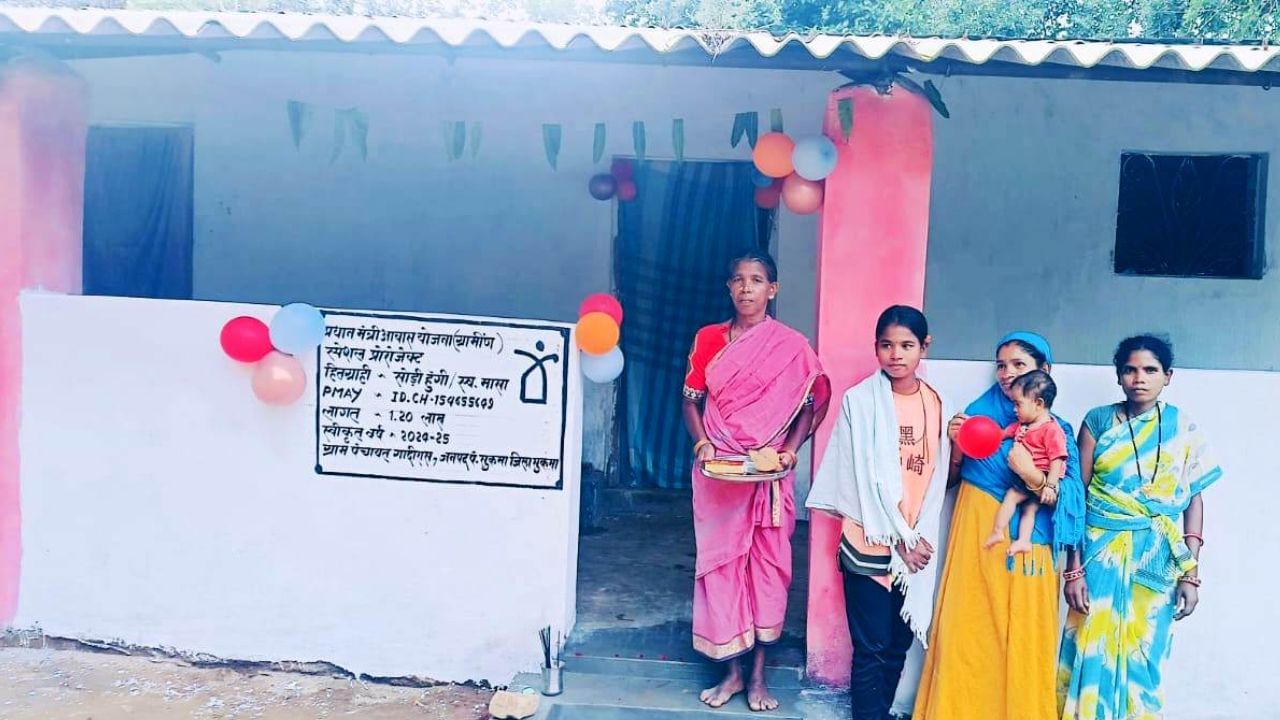In a significant step toward reintegrating families affected by Naxal violence and surrendered extremists into the mainstream, the Chhattisgarh government is constructing around 3,000 houses under a special project linked to the Pradhan Mantri Awas Yojana (PMAY). The initiative, specially approved by the Central Government at the state’s request, forms part of a larger sanction of 15,000 houses for families who otherwise did not qualify under regular PMAY eligibility norms.
Under this special project, out of 5,000 identified families, 3,000 families have already received housing approvals. The first installment has been released to 2,111 families, and 128 families have received their second installment. Construction is progressing rapidly, even in extremely remote and inaccessible forested regions.
Among the success stories, Sodi Hungi from Sukma and Dashri Bai from Kanker have completed the construction of their homes within just three months, despite the rugged terrain and logistical challenges. Their homes were sanctioned in March 2025, construction began in May, and the houses were completed within the monsoon window—an exceptional feat in these circumstances.
The special housing project is breathing new life into families in Bastar division affected by Naxal violence and unrest. Surrendered extremists and their families are now seeing their dreams of safe, permanent homes take shape, thanks to strong support from government authorities, district administrations, and the community.
Remote Areas, Difficult Terrain—Yet a Home in Three Months
Dashri Bai Nuruti, a resident of Ulia Gram Panchayat, over 200 km from Kanker district HQ, lost her husband Doge Nuruti during a Maoist attack amid Assembly elections. Her home was sanctioned under the special PMAY project in March, and construction began in May. With resilience and support, her house was completed in just three months.
She explained the many challenges: lack of roads for four-wheelers, high transportation costs for materials, difficulty accessing labor during rains, and isolation that discouraged masons from even reaching the site. Yet, with active help from the Kanker district administration, Gram Panchayat officials, and PMAY team, her house was completed quickly.
Dashri Bai said: “This sensitive and effective policy by the government for victims and surrendered Naxals has changed our lives. Without this level of support, it wouldn’t have been possible.”
Sodi Hungi’s Home Brings Dignity After Years Under a Leaking Roof
In Oeiras village under Gadiras Gram Panchayat, Sukma, Sodi Hungi built her permanent house in just three months. Her husband, Masa Sodi, was killed by Naxals in 2005 on suspicion of being a police informer. Since then, the family lived in a leaking, thatched hut, exposed to rain and dangerous insects.
Under the special PMAY project, Sodi Hungi received a total of ₹1.35 lakh in three installments. With consistent technical guidance and supervision by Gram Panchayat, her home was completed in July 2025. Today, she lives in her new concrete home with her family—a symbol of long-awaited security and dignity.
Sukma Leads in Beneficiaries, Followed by Bijapur and Narayanpur
Till date, nearly 3,000 homes have been sanctioned under the special project across LWE-affected regions: Sukma – 984 families (highest), Bijapur – 761, Narayanpur – 376, Dantewada – 251, Bastar – 214, Kondagaon – 166, Kanker – 146, Gariaband – 27, Balrampur-Ramanujganj – 25, Manpur-Mohla-Ambagarh Chowki – 23
CM Vishnu Deo Sai: “Our Government is Committed to Building Trust, Development and Rehabilitation”
Chief Minister Shri Vishnu Deo Sai emphasized that the Chhattisgarh government is working strategically on the principles of trust, development, and rehabilitation in Naxal-affected areas. He said that the state specially appealed to the Centre to approve 15,000 houses under a customized scheme for families not covered under standard PMAY norms.
“This project is not just about construction. It is about restoring faith, creating stability, and building a safe future for families who have suffered years of neglect and fear. That homes are being completed within three months in the most difficult terrains shows the power of collective will—government, administration, and the people together making the impossible happen,” CM Sai said.
He added that the government is firmly committed to ensuring that every eligible family in these areas receives a permanent, dignified home.
Dy CM Vijay Sharma: “This is an historic step towards justice and dignity”
Deputy Chief Minister and Home Minister Shri Vijay Sharma remarked that this initiative is a key part of the government’s rehabilitation, security, and dignity strategy for lasting peace and inclusive development in Naxal-affected regions.
“The special PMAY project reflects a sensitive and strategic shift—ensuring that victims of violence and surrendered extremists are not left behind. Examples like Sodi Hungi and Dashri Bai prove that when the government is empathetic and the administration is proactive, development can reach even the most remote corners,” he said.
Sharma reaffirmed that the mission is to ensure every affected family gets not only a roof, but also the respect and safety they deserve. The mission is being implemented with full commitment and clear intent to transform lives.
